Troop 413 Braves the Elements to Explore the California Mountains
Tristan Sword and his father sat by an alpine lake enjoying a picnic lunch. After a challenging up-and-down hike the previous day, chilling by the pristine water felt nice.
But as they relaxed, dark clouds began blanketing the sky — a hailstorm was approaching.
“The clouds got really bad,” the 15-year-old Life Scout says. “Then, wham! A piece of ice hit me in the face. There was an entire wall of ice coming down. It was so bad.”
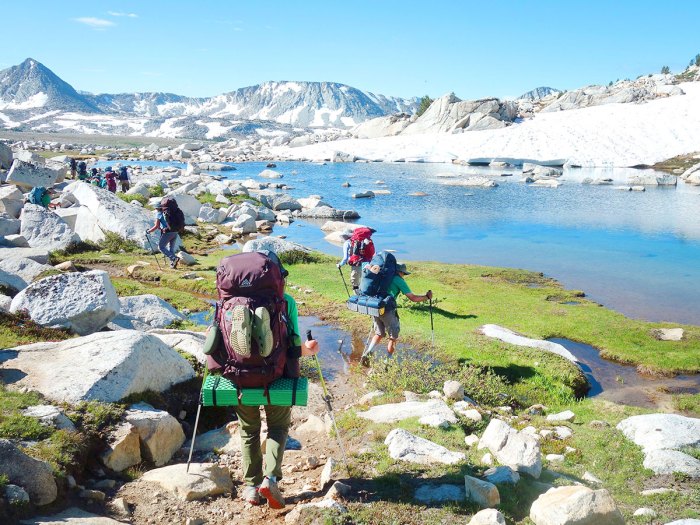
Tristan and his dad scrambled back to camp as marble-sized pellets of ice poured down around them. Along with the rest of Troop 413, they huddled inside their tents, waiting for the tempest to pass.
Hail covered the ground the next day, but that didn’t faze the Scouts. They were veterans. For the whole trek, they had crossed snow fields, braved staggering altitudes and battled swarms of mosquitoes.
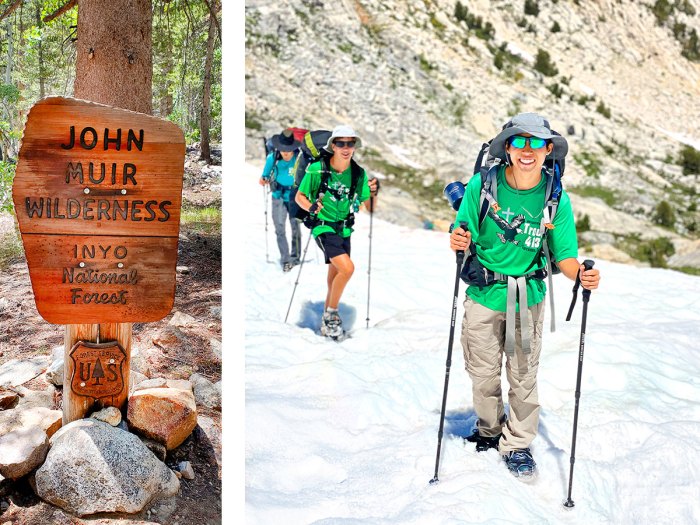
Joshua Terashima (front) and Elijah Pearson trek across a snow field in the Sierra Nevadas. The troop trekked through the John Muir wilderness, named after naturalist John Muir. Muir was instrumental in the development of our first national parks.
INTO THE MOUNTAINS
Every summer, the Scouts from Torrance, California, head into the mountain range along the state’s eastern side for a weeklong trip. The Sierra Nevada range boasts mountain peaks more than 14,000 feet tall.
Last summer, Troop 413 traversed about 50 miles in the Sierras, stopping by lakes and attempting to summit a 12,245-foot peak along the way. Rocky white mountains splattered with snow patches jutted high above passes and meadows green with pine and fir trees where the troop would camp, sometimes near lakes.
“We heard it was a beautiful place,” says Joshua Terashima, a 14-year-old Life Scout. “Our goal was to give everyone a good experience.”
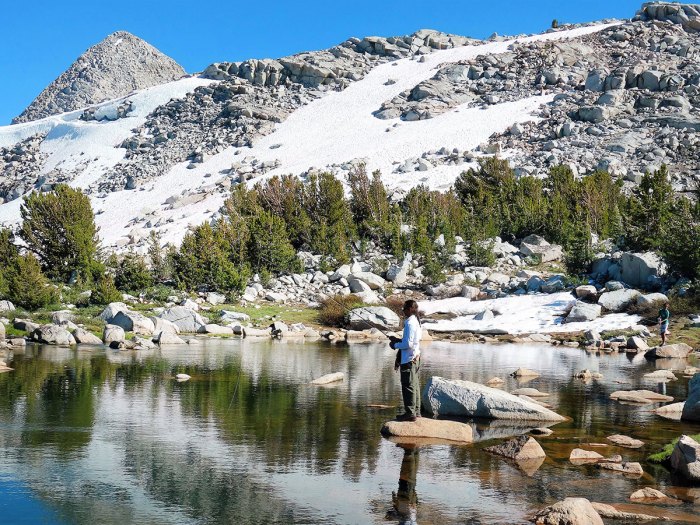
James Pinner stands on a rock to fish in an alpine lake.
To do that, the Scouts needed to Be Prepared. They completed two training hikes with big changes in elevation, one of which required the troop to trek through snow.
“That snow trip helped,” says Life Scout James Pinner, 17. “During this trip, we got to use crampons for the first time. Some of us had never heard of crampons. This trip, we ended up hiking in snow a lot of the time. On the first day, we got to test out our gear.”
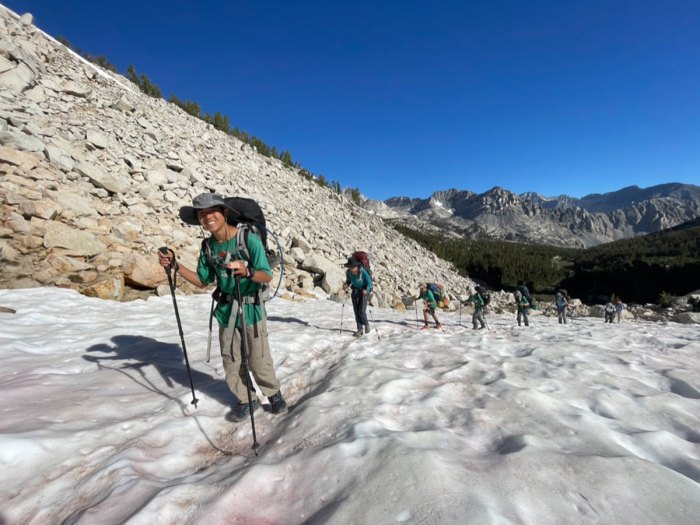
Joshua Terashima leads the troop up Pine Creek Pass.
FACING ADVERSITY
Having the right gear can make your trip more enjoyable, especially if you know how to use it. Spiked crampons provide more traction while hiking in the snow.
“They just strap onto your feet,” says Jacob Kotleba, 14, a Star Scout. “You stomp the snow a little bit to make it easier for the next hikers to walk.”
Snow wasn’t the only challenge for the group. They also hiked across streams and swatted mosquitoes. Some Scouts tried natural insect repellents, but what worked better were repellents with DEET as the active ingredient. Covering their faces and necks with mosquito netting also helped.
“Our longest day was probably the second day,” says Micah Bernard, 14, a Star Scout. “It was straight down and straight up. It was a tricky day.”
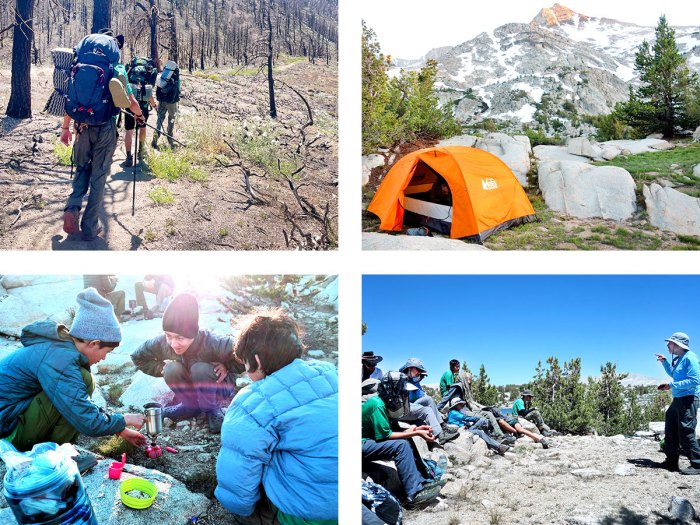
Top left: Before their weeklong trek, the Scouts went on training hikes, like this one near San Bernardino Peak. Top right: Aaron Kelly peeks out of his tent. Bottom left: Aaron Kelly (left) and Elijah Pearson prepare oatmeal for breakfast. Oatmeal is a healthy meal that is easy to pack for the trail. Bottom right: Stephen Kotleba leads a devotional.
After 12 miles on the second day, the group attempted to scale a nearby peak. It didn’t go as planned. “I was climbing, and my left foot slipped,” Joshua says. “My fingers bent all the way backward.”
The guys called off their summit attempt so they could attend to their injured friend. The safety and well-being of your crew should always come first. To Be Prepared for a remote high-adventure trip, you can take wilderness first-aid courses offered by Scouting America. An adult leader who was a former paramedic bandaged up Joshua.
When plans don’t go your way, it can be easy to get discouraged. But Troop 413 remembered the Scout Oath and Law. They motivated each other during their daily devotionals.
“It’s about keeping going, making it through with God’s help,” says Elijah Pearson, a 14-year-old Star Scout. “It’s a great time of reflection.”
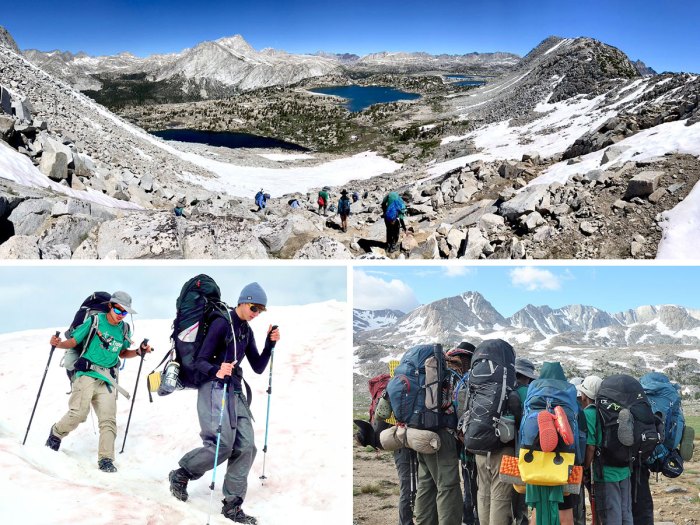
Top: The group descends from its summit attempt at Pilot Knob. Bottom left: Joshua Terashima (left) and Tristan Sword trek across a snow field with the help of crampons on their boots. Bottom right: The group takes a break to sing together.
AMAZING EXPERIENCE
As the trip ended, the guys reflected on what they’d learned: being prepared, packing the right gear and keeping a positive attitude.
“There was so little complaining,” James says. “For every complaint, there were five people saying here’s how we can overcome the problem.”
When you’re surrounded by natural majesty, it helps you to keep your perspective, too.
“I think we all had a great time,” Joshua says. “There were amazing views for us to see the creation all around us and marvel at what God has made for us.”
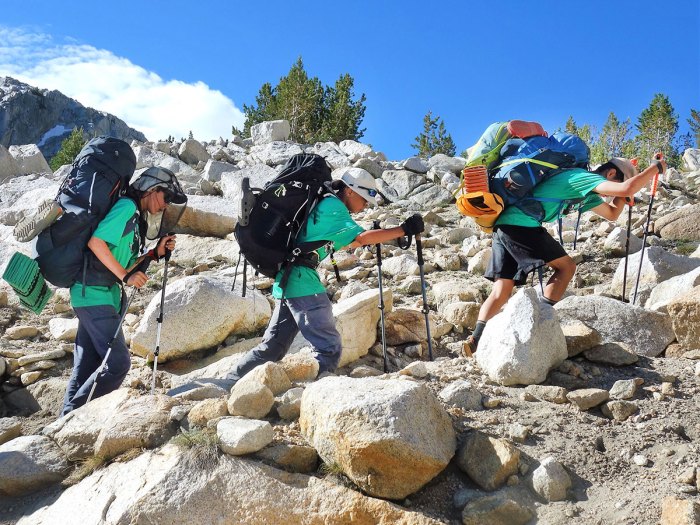
From left: Aaron Kelly, Jacob Kotleba and Stephen Park head up Pine Creek Pass during Troop 413’s trek in the Sierra Nevada mountains. Aaron is wearing a mosquito head net to ward off the insects.
Know Before You Go
When trekking at high altitudes, pay attention to your health. Headaches, loss of appetite, nausea, insomnia and unusual exhaustion can be signs of acute mountain sickness.
Reduced air pressure and lower oxygen levels contribute to this sickness, which might turn deadly in severe cases. Stay hydrated and stage your ascent, acclimating yourself to the higher elevation. If you start feeling these symptoms, stop or start going downhill until you feel better.
Snow Travel
Use special footwear to gain traction and stability on snow and ice. For flat terrain, place microspikes over your shoes. The spiked devices give you enough grip to keep you hiking. Crampons work similarly but are better suited for slopes since the spikes are bigger. If you’re hiking through powder or deep snow, bring along snowshoes to keep yourself from sinking.
Leave a Comment